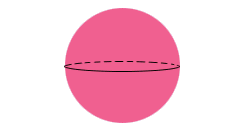
Did you know that it is possible to cut a solid ball into 5 pieces, and by re-assembling them, using rigid motions only, form TWO solid balls, EACH THE SAME SIZE AND SHAPE as the original? This theorem is known as the Banach-Tarski paradox.
So why can’t you do this in real life, say, with a block of gold?
If matter were infinitely divisible (which it is not) then it might be possible. But the pieces involved are so “jagged” and exotic that they do not have a well-defined notion of volume, or measure, associated to them. In fact, what the Banach-Tarski paradox shows is that no matter how you try to define “volume” so that it corresponds with our usual definition for nice sets, there will always be “bad” sets for which it is impossible to define a “volume”! (Or else the above example would show that 2 = 1.)
An alternate version of this theorem says (and you’d better sit down for this one): it is possible to take a solid ball the size of a pea, and by cutting it into a FINITE number of pieces, reassemble it to form A SOLID BALL THE SIZE OF THE SUN.
Presentation Suggestions:
Students will find this Fun Fact hard to believe. You might want to say that mathematics in this case reveals to us that we must be very careful about how we define things (like volumes) that seem very intuitive to us.
The Math Behind the Fact:
First of all, if we didn’t restrict ourselves to rigid motions, this paradox would be more believable. For instance, you can take the interval [0,1], stretch it to twice its length and cut it into 2 pieces each the same as the original interval. Secondly, if we didn’t restrict ourselves to a finite number of pieces, it would be more believable, too: the cardinality of the number of points in one ball is the same as that of two balls!
The proof involves studying group actions on the sphere, specifically, subgroups of the rotation group “SO(3)” that are free subgroups on 2 generators. Such strange subgroups allow one to construct “paradoxical” sets: sets which are congruent (under the group actions) to 2 or more “copies” of themselves! The proof also depends on the Axiom of Choice.
For the beginnings of an idea of how the proof goes, see the Fun Fact: Equidecomposability. For a related paradox, see the Fun Fact Sierpinski-Mazurkiewicz Paradox.
How to Cite this Page:
Su, Francis E., et al. “Banach-Tarski Paradox.” Math Fun Facts. <http://www.math.hmc.edu/funfacts>.
References:
Stan Wagon, The Banach-Tarski Paradox.
Or, see a shorter (unpublished) expository article written by F. Su.
Fun Fact suggested by:
Francis Su

